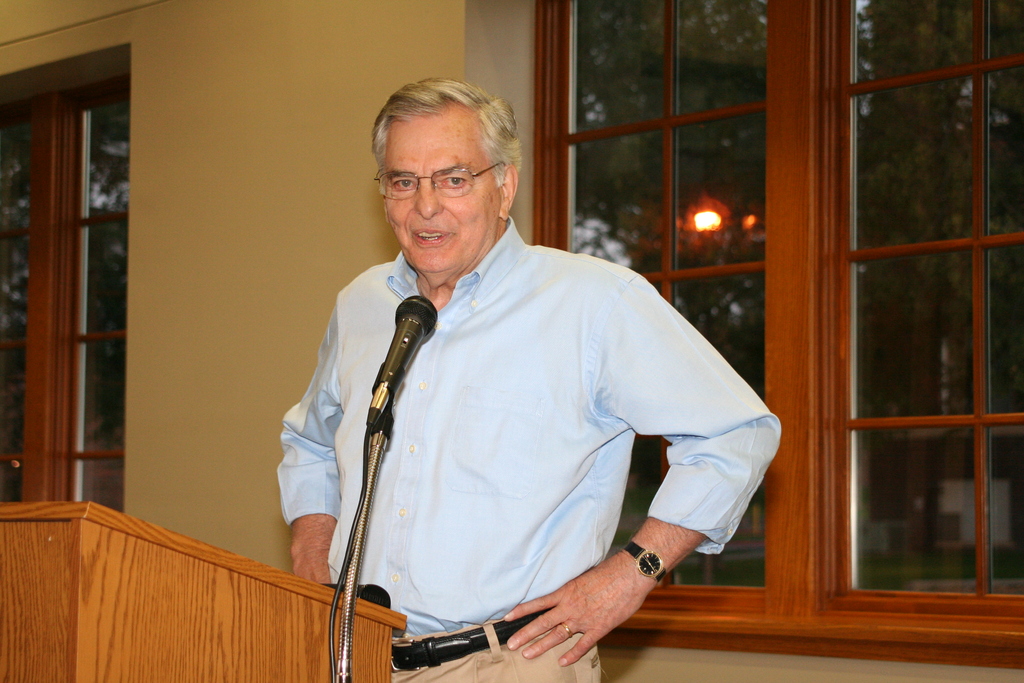Repeat of Depression, Dust Bowl unlikely, speaker says

No region suffered more during the drought and Depression in the 1930s than the Northern Great Plains that includes the Dakotas and Nebraska, according to Dr. Rolland Dewing, a long-time history professor at Chadron State College who returned to the campus to speak Wednesday night.
Now a resident of Renton, Wash., Dewing said although some historians have stated the southwestern United States felt the brunt of the Dust Bowl days, his research indicates conditions were even worse in the Northern Great Plains.
He said the drought of the 1930s was the worst in 350 years of recorded history. The conditions spawned dust clouds that were so thick at times street lights came on at noon, sheep and cattle died from inhaling too much dust and motor vehicles choked to a stop.
Making conditions even more intolerable, Dewing said, were swarms of grasshoppers so thick they sometimes blocked out the sun, often ate clothes off lines and even chewed the corks out of water jugs. He added that the late Virlyn Norgard, a longtime Crawford resident, said he sometimes slowed down on highway curves because grasshoppers were so think he was afraid his car might skid on them.
The author of a 200-page book on the effects of the Great Depression on the region, Dewing reported that farm income averaged less than $200 a year in the Dakotas during portions of the 1930s. In addition, he said South Dakota received almost three times more relief funding than Oklahoma. North Dakota received twice as much and Nebraska nearly as much.
The speaker also noted banks closed by the hundreds and unemployment reached 25 percent in the region. During this era, Dewing said the Dakotas experienced about a 20 percent population decline as people who could no longer tolerate the conditions fled to the West Coast. That included his family, which moved from northwestern North Dakota to Washington state in 1936.
Seventy percent of those who remained in North Dakota in '36 were on relief, he added.
Dewing said President Franklin Roosevelt's New Deal programs helped the nation slowly recover from the economic disaster. Prior to 1933, the speaker noted there was no old age pension system, federal unemployment compensation, aid to dependent children, farm subsidies or minimum wage laws. He said no ecomomic group received more help than farmers.
Further assistance came with the establishment of the Works Progress Administration and the Civilian Conservation Corps, which were designed to reduce unemployment while also improving the nation's infrastructure.
While jokes were often made that WPA, which drew 3.5 million workers, stood for "We Putter Around" or "We Pay for Anything," many of the projects are still highly visible in the Northern Great Plains and their value greatly exceeds the initial cost.
Dewing said WPA workers were paid an average of $41.52 a month and CCC workers received $30 a month, all but $5 of which was sent to their homes.
Despite the government assistance, by 1940 some 2.5 million people had moved from the Great Plains to the West Coast, making it the largest migration in American history.
Dewing also touched on the "Buffalo Commons" proposal made in 1987 by Frank Popper, a Rutgers land-use planner, and his wife, Deborah, a geographer. They recommended the government buy vast tracts of land in the Great Plains to graze buffalo and create national parks to attract tourists.
He said opponents point out that while the Poppers' demographic data was accurate, their solutions lacked validity. They also emphasize that the Great Plains remains the nation's breadbasket.
Although Nebraska is not included, an energy boom is spiking the economy of much of the Northern Great Plains, said Dewing, who taught history at Chadron State 32 years.
Wyoming easily leads the nation in coal production, Montana has vast coal reserves and, thanks to new horizontal drilling techniques and record oil prices, an oil boom is underway in the Williston Basin of western North Dakota and eastern Montana.
The U.S. Geological Survey recently proclaimed the basin holds at least 4 billion barrels of recoverable, top-quality, sweet light crude oil. Also, an almost inexhaustible supply of easily accessible lignite coal in North Dakota is feeding 12 power plants that generate electricity for 2 million homes, Dewing stated.
Dewing noted the Great Depression has left a couple of unfortunate legacies. He said whenever there is sharp drop in the stock market, warnings are issued that a Wall Street crash similar to 1929 is imminent and a period of drought causes concern that another Dust Bowl is approaching.
But he said government controls have been put in place to keep a huge financial crisis from recurring and agricultural conservation practices that grew out of the 1930s make another Dust Bowl highly unlikely.
Category: Campus News, Historical
